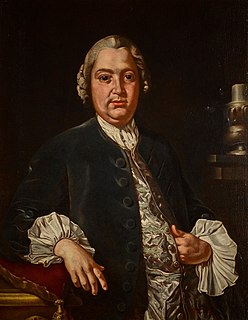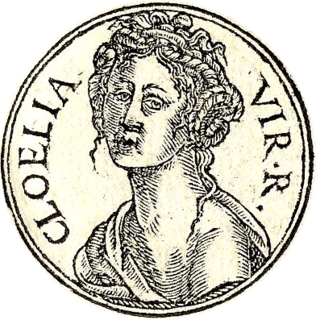Related Research Articles

Pietro Antonio Domenico Trapassi, better known by his pseudonym of Pietro Metastasio, was an Italian poet and librettist, considered the most important writer of opera seria libretti.

Johann Adolph Hasse was an 18th-century German composer, singer and teacher of music. Immensely popular in his time, Hasse was best known for his prolific operatic output, though he also composed a considerable quantity of sacred music. Married to soprano Faustina Bordoni and a great friend of librettist Pietro Metastasio, whose libretti he frequently set, Hasse was a pivotal figure in the development of opera seria and 18th-century music.

Niccolò Jommelli was a Neapolitan composer. He was born in Aversa and died in Naples. Along with other composers mainly in the Holy Roman Empire and France, he was responsible for certain operatic reforms including reducing ornateness of style and the primacy of star singers somewhat.

Opera seria is an Italian musical term which refers to the noble and "serious" style of Italian opera that predominated in Europe from the 1710s to about 1770. The term itself was rarely used at the time and only attained common usage once opera seria was becoming unfashionable and beginning to be viewed as something of a historical genre. The popular rival to opera seria was opera buffa, the 'comic' opera that took its cue from the improvisatory commedia dell'arte.

Cloelia was a legendary woman from the early history of ancient Rome.

Pasquale Anfossi was an Italian opera composer. Born in Taggia, Liguria, he studied with Niccolò Piccinni and Antonio Sacchini, and worked mainly in London, Venice and Rome.
Demofonte is an opera seria libretto by Metastasio. The libretto was first set by Antonio Caldara in 1733, but remained popular throughout the eighteenth century and was set over seventy times.

Giuseppe Nicolini was an Italian composer who wrote at least 45 operas. From 1819 onwards, he devoted himself primarily to religious music. He was born and died at Piacenza.
Ezio is an Italian masculine name, originating from the Latin name Aetius.
Domenico Fischietti (1725–1810) was an Italian composer.
Marcello Bernardini was an Italian composer and librettist. Little is known of him, save that he wrote 37 operas in his career. His father was most likely the composer Rinaldo di Capua.
Clelia is a feminine given name derived from the Latin Cloelia, associated with the root of the verb cluere "to have renown, fame," and the name therefore means "illustrious, famous." In Roman legend Cloelia was a maiden who was given to an Etruscan invader as a hostage, but managed to escape by swimming across the Tiber.

Il trionfo di Clelia is an 18th-century Italian opera in three acts by the Czech composer Josef Mysliveček composed to a libretto by the Italian poet Metastasio. It was common in the 1760s for composers to set Metastasian texts written decades before. Exceptionally, the text for Il trionfo di Clelia, first produced in Vienna in 1762, was almost new when Mysliveček was commissioned to compose his setting for Turin, and all of the aria texts used for his setting derive from the original libretto. This opera belong to the serious type in Italian language referred to as opera seria.
Ezio is a baroque opera in three acts composed by Christoph Willibald Gluck, staged in 1750 and revised in 1763.

Luca Antonio Predieri was an Italian composer and violinist. A member of a prominent family of musicians, Predieri was born in Bologna and was active there from 1704. In 1737 he moved to Vienna, eventually becoming Kapellmeister to the imperial Habsburg court in 1741, a post he held for ten years. In 1765 he returned to his native city where he died two years later at the age of 78. A prolific opera composer, he was also known for his sacred music and oratorios. Although his operas were largely forgotten by the end of his own lifetime and most of their scores lost, individual arias as well some of his sacred music are still performed and recorded.
Antigono is a three act opera seria composed by Christoph Willibald Gluck. It premiered February 9, 1756, at the Teatro di Torre Argentina in Rome, Italy. The Italian libretto was written by Pietro Metastasio, who was considered to be the most important opera seria librettist. Antigono was the only opera that Gluck ever premiered in Rome. This allowed him to reuse several arias and an entire introduction from some of his other operas, L’innocenza Giustificata, L’cinesi, and La Danza.
Il trionfo di Clelia is an Italian opera libretto by Metastasio originally written for Johann Adolf Hasse and premiered in Vienna in 1762.L Among the many subsequent settings are the setting by Gluck, and setting by Josef Mysliveček which premiered in Turin in 1767.

Giovanni Ambrogio Migliavacca was an Italian poet and librettist. A student and protégé of Metastasio, he was primarily active in the court theaters of Dresden and Vienna. His most successful work was the libretto for the opera Solimano, first set by Johann Adolph Hasse in 1753 and subsequently set by 18 other composers in the course of the next 50 years.
Mario Aspa was an Italian composer. He composed over 40 operas, the most successful of which were Paolo e Virginia and II Muratore di Napoli. He also composed two ballets and a Requiem Mass which was performed on the death of Vittorio Emmanuele II in 1878.
Ipermestra is an opera libretto by Pietro Metastasio first set by Johann Adolph Hasse 8 January 1744, and in the November of the same year by Christoff Willibald Gluck.
References
- ↑ Ruston, Julian, in Holden, Amanda (Ed.) (2001), The New Penguin Opera Guide, p. 320. New York: Penguin Putnam. ISBN 0-140-29312-4
- 1 2 Ashley, Tim (25 June 2012). "Il Trionfo di Clelia – review". The Guardian . Retrieved 16 October 2014.
- ↑ Casaglia, Gherardo (2005). "Il trionfo di Clelia". Almanacco Amadeus. Retrieved 16 October 2014 (in Italian).